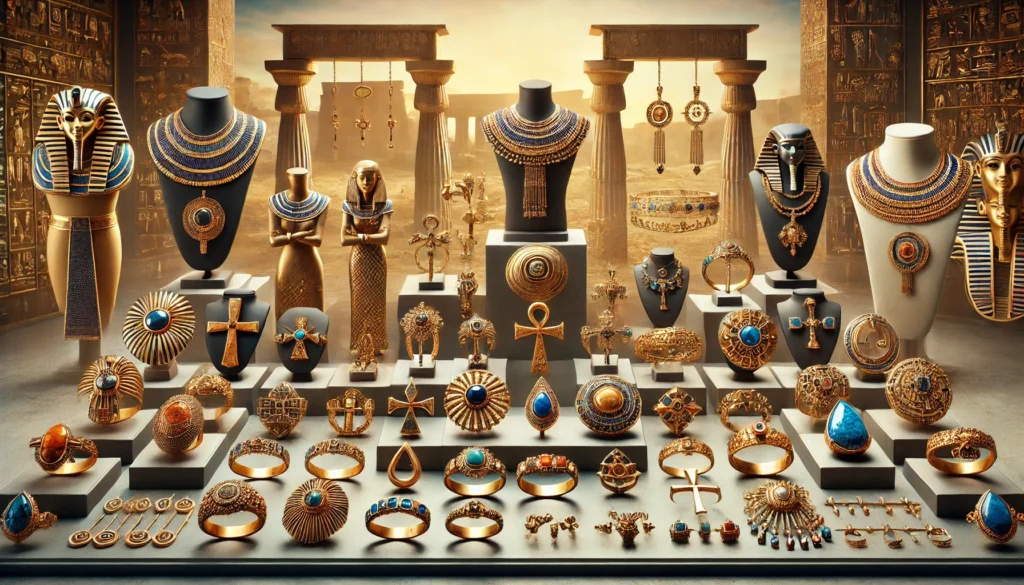Jewelry has been a fundamental form of personal adornment and expression throughout human history, with its origins dating back thousands of years. From ancient Egypt to Mesopotamia, India, Greece, Rome, and China, different civilizations made significant contributions to the development and evolution of jewelry. But what role did jewelry play in these early societies, and how did it reflect cultural, religious, and social values? Let’s take a closer look at the history of jewelry in some of the most prominent ancient civilizations.

What Role Did Jewelry Play in Ancient Egypt?
The ancient Egyptians are perhaps the most famous early civilization for their elaborate and symbolic jewelry. Jewelry was not only a form of adornment but also a spiritual and cultural symbol in ancient Egyptian society. The Egyptians crafted stunning pieces from precious materials such as gold, silver, turquoise, lapis lazuli, and other semi-precious stones.
One of the defining characteristics of Egyptian jewelry was the use of symbolic motifs, many of which represented religious and spiritual beliefs. For example, the scarab beetle, which appeared frequently in Egyptian jewelry, symbolized rebirth and protection. Another common motif was the ankh, representing eternal life. Jewelry was often designed with these motifs to serve both decorative and protective purposes, and many pieces were worn in life and buried with the deceased to accompany them into the afterlife.
Egyptians believed that jewelry could provide spiritual benefits and protection from evil forces. As a result, the wealthier individuals adorned themselves with pieces that reflected both their status and their belief in divine protection.
How Did Mesopotamian Civilizations Influence Jewelry Design?
The ancient civilizations of Mesopotamia, including the Sumerians, Babylonians, and Assyrians, were also known for their impressive jewelry-making techniques. Mesopotamian artisans worked with a wide range of materials, such as gold, silver, lapis lazuli, carnelian, and agate, creating intricate and ornate pieces.
Religious and cultural symbols played a significant role in Mesopotamian jewelry. Much like the Egyptians, Mesopotamians used jewelry as both an adornment and a way to honor their gods and goddesses. Jewelry was often designed to reflect religious themes, with amulets and charms crafted to offer protection or invoke the favor of deities.
The Sumerians, for instance, were known for their detailed headdresses and necklaces that incorporated beads made of semi-precious stones. The jewelry designs of this region often reflected the grandeur of their temples and the status of the wearer, signaling wealth and power.
What Was the Importance of Jewelry in Ancient India?
Jewelry has held a central place in Indian culture for thousands of years, and its importance can be traced back to the Indus Valley Civilization (circa 3300-1300 BCE), one of the world’s earliest urban societies. Indian jewelry artisans were known for their intricate craftsmanship, and they worked with a variety of materials, including gold, silver, copper, and a dazzling array of gemstones such as diamonds, rubies, and sapphires.
What sets Indian jewelry apart is its complexity and attention to detail. Filigree work (delicate metalwork involving twisted threads of metal) and elaborate designs featuring floral patterns, animals, and deities were hallmarks of Indian jewelry. Each piece of jewelry held cultural and often religious significance, and wearing certain types of jewelry during festivals and rituals was believed to bring prosperity and protection.
Jewelry also played a significant social role in Indian society. It was not just a symbol of wealth and status, but also an integral part of weddings, religious ceremonies, and daily life. In fact, Indian jewelry traditions, particularly those from the ancient period, continue to influence modern jewelry designs in the region today.
How Did Ancient Greece and Rome Use Jewelry to Showcase Status?
In ancient Greece and Rome, jewelry was often a symbol of wealth, social status, and power. Greek jewelry designs were deeply influenced by their mythology and featured motifs such as laurel wreaths, gods and goddesses, and animals. Laurel wreaths, for instance, were often worn as crowns by victorious athletes or revered leaders, symbolizing honor and triumph.
Greek artisans used materials like gold, silver, and bronze, along with gemstones such as amethyst and emeralds, to craft their pieces. Their craftsmanship was renowned for its elegance and simplicity, with an emphasis on balance and symmetry.
In contrast, Roman jewelry tended to be more opulent and grandiose, reflecting the wealth and power of the Roman Empire. Roman citizens, particularly those of high rank, adorned themselves with rings, necklaces, and earrings made of gold and pearls. Signet rings, which featured engraved designs, were commonly worn by men to signify their authority and identity. The use of gemstones such as sapphires, rubies, and emeralds also became popular, showcasing the wealth and influence of the Roman elite.
What Significance Did Jewelry Hold in Ancient China?
The ancient Chinese civilization has a long and distinguished history of jewelry making, with a particular emphasis on materials such as jade, gold, silver, and other gemstones. Jade, in particular, was highly revered in Chinese culture and symbolized purity, nobility, and immortality.
Chinese jewelry was often associated with auspicious symbols and cultural motifs. Dragons, phoenixes, and other mythological creatures were frequently featured in jewelry designs, representing power, strength, and good fortune. Intricate metalwork and detailed craftsmanship were hallmarks of Chinese jewelry, and pieces were often worn not only for adornment but to convey social status and spiritual beliefs.
Jade amulets and pendants, for example, were believed to provide protection and good fortune to the wearer. The connection between jade and the spiritual realm was so profound that it was often buried with the deceased to ensure safe passage into the afterlife.
How Has Jewelry Influenced Cultures Throughout History?
Across these ancient civilizations, jewelry was more than just a form of decoration—it was a vital means of expressing cultural values, religious beliefs, and social status. Whether worn for protection, spiritual guidance, or simply as a sign of wealth and power, jewelry has played an integral role in shaping the identities of individuals and entire societies.
Today, the legacy of ancient jewelry continues to influence modern jewelry design. The timeless motifs, intricate craftsmanship, and cultural significance of ancient jewelry have inspired artisans and wearers alike, preserving the rich history of jewelry across generations.
